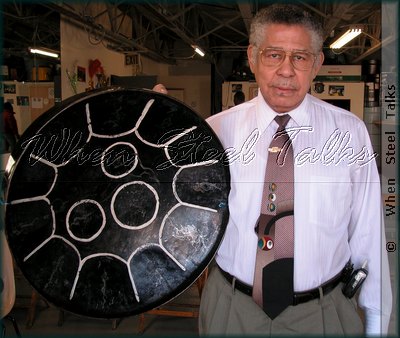
Ellie Mannette, left; Khalick Hewitt at right during workshop break session
Dr. Mannette give an informative presentation for over an hour about the early years of the steelband movement. Apart from speaking about his contribution, he also included other stalwarts like Anthony Williams (Pan Am North Stars Steel Orchestra), Rudolph Charles (Desperadoes Steel Orchestra) and Bertie Marshall (Hilanders Steel Orchestra) and spoke of their contributions and innovations to the steelband movement. Also, Dr. Mannette presented some of his steelpan instruments that he built at the West Virginia University where he heads the Pan Tuning Project.
The clinic opened with an introduction from Dr. Mannette's manager Ms. Kaethe George. Ms. George told the audience of over seventy people that it was a privilege for the University to have Dr. Mannette as a teacher and innovator of the steelpan. She acknowledged that the steelpan was the only instrument created in the 20th century by teenagers on a small British colony named Trinidad. She explained that Dr. Mannette had over thirty students in his project who were responsible for building the instruments under his supervision. (Trinidad, take heed).

Audience takes in Ellie Mannette's Brooklyn workshop
The audience at the Pan Clinic was made up of mostly Trinidadians. There were a few whites. The mostly Trinidadian audience was spellbound and fascinated at the instruments that were on display at the clinic. Ms. George explained to the audience the business side of the Pan Tuning Project. She said that Dr. Mannette and herself were business partners, and had created an organization to distribute the sale of his instruments, Mannette Steel Drums with a web site address www.mannettesteeldrums.com. I urge everyone to take a look.

Ellie Mannette with his 1946 Tenor pan
Dr. Mannette opened his lecture by introducing his instruments and some of the tools used to build the instrument. He said that he was grateful to the University for their assistance. And, he was especially thankful for the assistance that he received from the University's Engineering Department who lend their expertise to the development of the instrument. He displayed to the audience a steelpan (soprano) that he built in 1946 with 16 notes. It was tuned and he played a popular carnival calypso of the period "Run your Run Kaiser Wilhelm." The elders in the audience were delighted because they remembered. Next, Dr. Mannette spoke of his concerns for the instrument. He displayed the two types of steelpan instruments he built, one to be used for recording and the other for outdoor events like the Panorama festival.
Dr. Mannette lamented the fact that the instrument lacked financial and visionary support in the island of its birth. He was aware of the fact that some Trinidadians felt he had betrayed them by giving his expertise to a foreign country. But he did not see it as a betrayal, more as a contribution since he was still promoting the instrument with an institution like West Virginia University that was willing to put their money into a the scientific and more accurate production of the steelpan. All others wanted to do something for the instrument but - only talk with no action. None were putting up their money, or funding the necessary expertise.

Khalick Hewitt at right, sharing a few words
with Dr. Ellie Mannette, left
He reminded the audience that the instrument is still in its infancy, being the youngest of musical instruments. But, he said that he could not wait for Trinidad to get their act together and be ready to financially invest in developing the instrument. He felt that today's technology had made it imperative that it be used for the development of the steelpan. And, any institution ready to put their money and expertise toward that goal should be supported. He was serious when he said that his students (at the University) are ambitious, anxious and skillful enough to want to take over. But, he still wanted to see the instrument remain in the hands of Trinidadians. We shall see.
Next, Dr. Mannette explained that the old ways of creating a steelpan is no more. He said that all his instruments are built using modern technology. For example, the sinking of the drum was done by compressors. The marking and shaping of the notes were done with an electric drill. Lastly, burning the drum was no longer used. He gave a demonstration of the sounds of his instruments by playing each of those he had brought with him for the Pan Clinic.
He pointed out that West Virginia University was making overtures to the University of the West Indies in Trinidad to create a joint venture to build and promote the instrument. Lastly, he promised to return to Brooklyn and conduct a symposium about standardization and the urgency of creating music for the instrument. The lecture ended with a question and answer period. Dr. Mannette answered every question with historical references. The enthusiasm of the audience showed that people know quality and will give an ear to anyone who promotes the instrument.

Khalick J. Hewitt and Dr. Ellie Mannette
The importance of this Pan Clinic cannot be overstated because the 'national instrument' is now an international instrument having interested parties from all over the world. At Universities throughout the United States there are steelband orchestras. It is safe to say that a steelband can be found in nearly every country in today's world. I have seen websites in Africa, Israel, Japan, China, Switzerland, Norway, Canada and Germany. The financial potential of the instrument is increasing. Once standardization occurs it will become the model, and then all the 'ole talk' will be over. The era of globalization shall determine the marketability of the instrument.
To the rendezvous of victory,
Khalick J. Hewitt
President & Founder
International Steelpan & Calypso Society
- Ellie Mannette in Brooklyn - in Pictures
- Click here for Exclusive Video Interview
- Related article: Mannette Talks Pan In Brooklyn
Leave a comment in the WST forum






